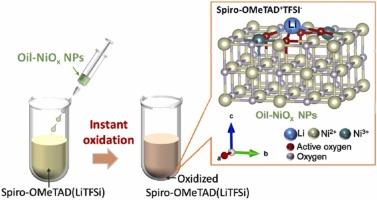NiOx nanoparticles as p-dopants for instant oxidation of Spiro-OMeTAD enabling high-performance and stable perovskite solar cells
IF 17.1
1区 材料科学
Q1 CHEMISTRY, PHYSICAL
引用次数: 0
Abstract
Perovskite solar cells (PSCs) have demonstrated remarkable advancements, achieving power conversion efficiencies (PCEs) exceeding 26 %. A critical component in these devices is 2,2′,7,7′-tetrakis[N,N-di(4-methoxyphenyl)amino]-9,9′-spirobifluorene (Spiro-OMeTAD), which serves as the conventional hole transport material (HTM) in “n-i-p” structural PSCs. However, the optimal functionality of Spiro-OMeTAD necessitates doping with lithium bis(trifluoromethanesulfonyl)imide (Li-TFSI) and 4-tert-butylpyridine (tBP), both of which introduce stability challenges. Li-TFSI is highly hygroscopic, leading to moisture-induced degradation, while tBP exhibits high volatility, compromising the long-term integrity of the hole transport layers (HTLs). Additionally, the preparation of Spiro-OMeTAD typically requires a prolonged oxidation process (8–72 h) to achieve a sufficiently oxidized state with enhanced charge transport properties. In this study, stable oleyl amine (OAm) ligand nickel oxide nanoparticles (noted as the oil-NiOx NPs) were employed as p-type dopants and instantaneous oxidization agents to accelerate the oxidation of Spiro-OMeTAD. This substitution enhances the dispersion of Li-TFSI in chlorobenzene (CB) and promotes the formation of a uniform HTL film, while simultaneously introducing an immediate oxidation pathway that markedly accelerates the oxidation of Spiro-OMeTAD. In this process, Li+ interacts with the NiOx lattice to generate Ni3+ species, which act as transient oxidizing agents and drive the rapid oxidation of Spiro-OMeTAD. Consequently, power conversion efficiency (PCE) of 24.20 % was achieved, along with enhanced stability under moisture (55 % RH), thermal (85°C), and light exposure conditions, maintaining 94 %, 61 %, and 80 % of their initial efficiency after more than 800 h of continuous operation.

NiOx纳米颗粒作为即时氧化Spiro-OMeTAD的p掺杂剂,实现高性能和稳定的钙钛矿太阳能电池
钙钛矿太阳能电池(PSCs)取得了显著的进步,实现了超过26%的功率转换效率(pce)。这些器件的关键成分是2,2 ',7,7 ' -四基[N,N-二(4-甲氧基苯基)氨基]-9,9 ' -螺双芴(Spiro-OMeTAD),它作为“N- i-p”结构psc中的传统空穴传输材料(HTM)。然而,Spiro-OMeTAD的最佳功能需要掺杂锂二(三氟甲烷磺酰)亚胺(Li-TFSI)和4-叔丁基吡啶(tBP),这两种物质都会带来稳定性挑战。Li-TFSI具有高度吸湿性,导致水分诱导降解,而tBP具有高挥发性,损害了空穴传输层(HTLs)的长期完整性。此外,制备Spiro-OMeTAD通常需要较长的氧化过程(8-72小时)才能达到充分氧化状态,并增强电荷输运特性。本研究采用稳定的油酰胺(OAm)配体氧化镍纳米颗粒(oil-NiOx NPs)作为p型掺杂剂和瞬时氧化剂加速Spiro-OMeTAD的氧化。这种取代增强了Li-TFSI在氯苯(CB)中的分散,促进了均匀HTL膜的形成,同时引入了一个即时氧化途径,显著加速了Spiro-OMeTAD的氧化。在此过程中,Li+与NiOx晶格相互作用生成Ni3+, Ni3+作为瞬态氧化剂,驱动Spiro-OMeTAD的快速氧化。因此,实现了24.20%的功率转换效率(PCE),并在湿度(55% RH),热(85°C)和光照条件下增强了稳定性,在连续运行超过800小时后保持其初始效率的94%,61%和80%。
本文章由计算机程序翻译,如有差异,请以英文原文为准。
求助全文
约1分钟内获得全文
求助全文
来源期刊

Nano Energy
CHEMISTRY, PHYSICAL-NANOSCIENCE & NANOTECHNOLOGY
CiteScore
30.30
自引率
7.40%
发文量
1207
审稿时长
23 days
期刊介绍:
Nano Energy is a multidisciplinary, rapid-publication forum of original peer-reviewed contributions on the science and engineering of nanomaterials and nanodevices used in all forms of energy harvesting, conversion, storage, utilization and policy. Through its mixture of articles, reviews, communications, research news, and information on key developments, Nano Energy provides a comprehensive coverage of this exciting and dynamic field which joins nanoscience and nanotechnology with energy science. The journal is relevant to all those who are interested in nanomaterials solutions to the energy problem.
Nano Energy publishes original experimental and theoretical research on all aspects of energy-related research which utilizes nanomaterials and nanotechnology. Manuscripts of four types are considered: review articles which inform readers of the latest research and advances in energy science; rapid communications which feature exciting research breakthroughs in the field; full-length articles which report comprehensive research developments; and news and opinions which comment on topical issues or express views on the developments in related fields.
 求助内容:
求助内容: 应助结果提醒方式:
应助结果提醒方式:


